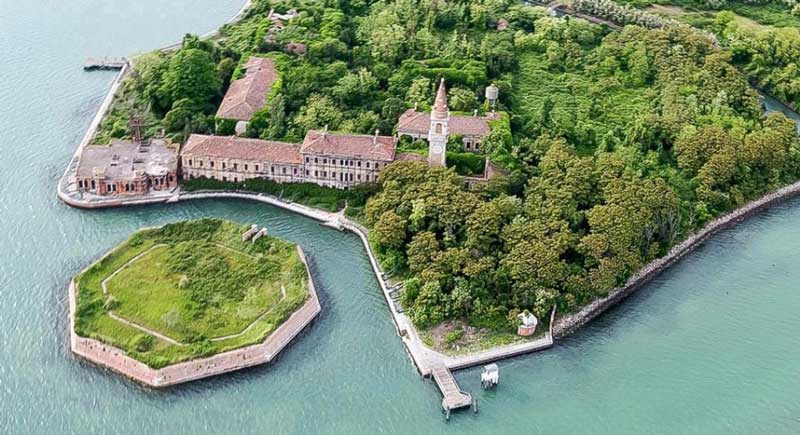
Prohibition of any type always ends up being attractive and attraction results in strong curiosity. This curiosity in its turn leads to an irresistible desire and a strong urge to know more about the forbidden. The urge to know the unknown has pulled people from the deep rainforest to the top of Everest. Yet, till today, there are certain spots across the globe, which are shrouded in mystery, as they are entirely forbidden to the visitors. However, the urge to know more about the seemingly attractive forbidden, could finally turn to be fatal attractions.

Located about 25 miles off the coast of Brazil in the Atlantic Ocean, the small Snake Island is the only home of the critically endangered Golden Lancehead snakes, one of the most venomous vipers in the world. Once the island was attached to the mainland, but the snakes became trapped on the Island around 10,000 years ago, when rising sea level separated the landmass from the coast. The Island is about 430,000 sq m in area and it is estimated that there are 2,000 to 4,000 snakes in the Island. In 1909, a lighthouse was constructed to steer ships away from the island and the Island became abandoned, when the lighthouse was automated. Except the Brazilian Navy and a few selected researchers, the Island is closed to the public to protect the snake population.

North Sentinel Island is one of the small Andaman Islands in the Bay of Bengal. It is the home of the Sentinelese, believed to be the last pre-Neolithic tribe in the world to remain isolated and appear to have survived the 2004 Asian tsunami. They have lived on the island for some 60,000 years and rejected any contact with the outside world. They are keen to protect their isolation and unhesitatingly shower arrows on any approaching outsiders. In fact, they have successfully protected themselves from any touch with the civilized world. The Island is prohibited to visitors of any kind and any approach closer than five nautical miles (9.26 km) is illegal. Recently, in November 2018, John Allen Chau, a 26-year-old American missionary, was killed by the Sentinelese during his attempted illegal trip to the forbidden island.

The Ise Grand Shrine, locally known as Ise Jingu, is perhaps the most revered shrine in Japan. Located in the city of Ise, a coastal city in the central Mie Prefecture on Japan’s main island of Honshu, it is dedicated to the Sun Goddess Amaterasu. The complex consists of two main shrines of Naiku or Kotai Jingu and Geku or Toyouke Daijingu, along with a large number of Shinto shrines centered on two main shrines. The shrine buildings are made of solid cypress wood and are rebuilt every year, treasures and artifacts are refurbished, and the deities are decorated with new apparels. However, except the Japanese imperial family; entry to both the sites is restricted and the commoners are not allowed beyond sight of the central structures, hidden behind four tall wooden fences. Even, the chief priest or priestess of Ise Shrine must come from the Imperial House of Japan, who is responsible for watching over the Shrine.


Located between Venice and Lido, a sandbar in the Venetian Lagoon in Italy, Poveglia is a small abandoned island. During 1379, when the Genoese fleet attacked Venice, the people of Poveglia were moved to the neighbouring Giudecca Island and after that it remained uninhabited in the subsequent centuries. Beginning from 1645, the Venetian government built five octagonal forts on the Island to protect and control the entrances to the lagoon. But, the Island was transformed into a temporary quarantine station in 1793, when several cases of the plague were detected on two incoming ships. Other plague sufferers were also forced to the island to die. The role changed in 1922, when the existing buildings on the Island were converted into an asylum for the mentally ill. It is alleged that in the asylum a doctor performed strange and cruel experiments on the inmates, who finally went mad and threw himself from the asylum's tall bell tower. The asylum was closed in 1968. Since then Poveglia was abandoned, sealed off to the public and the stories about ghosts and unusual moaning has earned its reputation as one of the most haunted islands in the world.

Situated in southwestern France, near the village of Montignac, the Lascaux Caves are the home to a series of stunning Paleolithic paintings, which are considered to be around 17,000 to 20,000 years old. Enlisted in the UNESCO World Heritage Sites in 1979, the entrance of the caves was discovered on 12 September 1940 by Marcel Ravidat, an 18 years old boy. He entered the caves, along with his three friends and was surprised to discover that the cave walls were covered with depictions of numerous animals. After proper excavation it was found that, among the paintings, horses are the most numerous, but deer, aurochs, ibex, bison, and even some felines are also there. Apart from the paintings, many flint tools, bone tools and around 1400 engravings were also found in the caves. Though the cave complex was opened to the public on July 14, 1948, it was closed in 1963, since the quantity of carbon dioxide, heat, humidity, and other contaminants produced by more than a thousand visitors per day badly damaging the paintings.
